Donatello, or Donato di Niccolo di Betto Bardi, is one of the important sculptors of all time. He started as a simple goldsmith apprentice, then he developed into the most influential Italian artist of the 15th century.
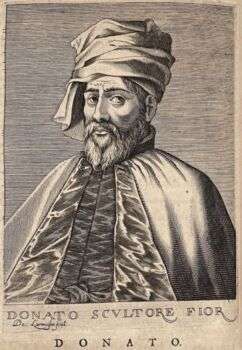
Image source: https://search.creativecommons.org/photos/2af1a4c7-8826-4282-aae0-df88bef4a4be by Nicolas de Larmessin and Esme de Boulonois
About His Life
Donatello was born in Florence around 1386. As a young man, he was a member of “Arte della Lana” and received artistic training from a local goldsmith. Additionally, he learned metallurgy and the fabrication of metals. In 1403, he apprenticed with metalsmith and sculptor Lorenzo Ghiberti. There, he assisted Ghiberti to create the bronze doors for the Baptistery of the Florence Cathedral. Then, he traveled to Rome and studied classical art and sculpture, which gave him a deep understanding of ornamentation and classic forms. His association with Brunelleschi likely influenced his development of the Gothic style that can be seen in much of Donatello’s early work. Moreover, Donatello maintained a lifelong friendship with the wealthy and famous Medici family and upon his retirement received from them an allowance to live on for the rest of his life. The artist died on December 13, 1466.
Donatello’s Major Sculpture Works
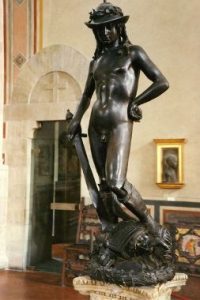
Image source: https://search.creativecommons.org/photos/1218661f-ff2c-4bf1-9dcd-d2e51622c6b2 by WVJazzman
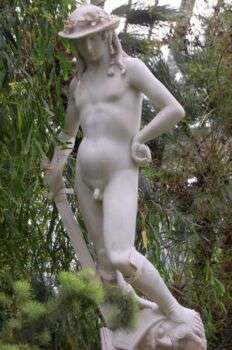
Image source: https://search.creativecommons.org/photos/6be626fc-bef3-4aa9-b8c3-2b6a456cdf12 by ketrin1407
- The Bronze Statue of David (1440): Commissioned by Cosimo de Medici for the Palazzo Medici, the sculpture was the first freestanding male nude statue since the era of Greek sculpture, and the first unsupported standing bronze statue cast during the Renaissance. Further, the style is known as contrapposto, a sculptural scheme, originated by the ancient Greeks.
- Marble sculpture of David
- Large figure St. Mark (1411-1413): In a niche on the exterior of Orsanmichele
- Seated St. John the Evangelist (1415): For the facade of the Cathedral;
- St George (1415-1417): His earliest work, which displays his radical move away from the prevalent Gothic style
- Prophet Habakkuk (1423–1425): also known as Lo Zuccone;
- Equestrian Statue of Gattamelata (1453): Located in Padua, which represents Erasmo da Narmi, a famous Venetian condottiere who died shortly before
- Penitent Magdalene (1453–1455): One of Donatello’s most renowned works and considered his greatest wooden masterpiece
- Judith and Holofernes (1460)
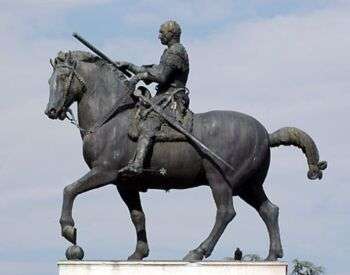
Image source: https://search.creativecommons.org/photos/8bb1df93-f45e-4663-ba74-b1e1892016b7 by rjhuttondfw
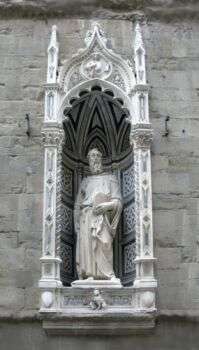
Image source:https://search.creativecommons.org/photos/5a6b2adf-4014-4044-8ca0-88fa9703e7b2 by Stefan Bauer, http://www.ferras.at
Other Works
- St. George Killing the Dragon (1416-1417): Introduced a new mode of relief and is also famous for being one of the first examples of central-point perspective in sculpture
- The Feast of Herod (1423-1427): one of Donatello’s earliest relief sculptures and his first bronze relief

Image source: https://search.creativecommons.org/photos/bb087e9e-ebe8-47e8-9f62-b17890f00875 by Jennifer Mei
Sometime around 1450, Donatello undertook a massive project for the church Saint Anthony of Padua, which included 7 life-size bronze statues, 21 bronze reliefs of various sizes, and a large limestone relief.
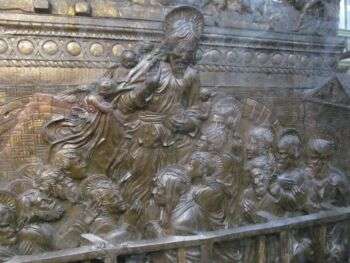
Image source: https://search.creativecommons.org/photos/062f8582-1a9a-4668-8128-653eada72d0a by virtusincertus
Features of Donatello’s Style
- Marble and bronze are often present, as he possessed an extensive knowledge of ancient sculpture
- In his sculptures, the human body is represented as a functional organism. In contrast to medieval art, the human personality radiates confidence in its worth
- He paid particular attention to characteristic facial features with exceptional expressive power
- Introduced a technique known as schiacciato, stiacciato or shallow relief, which became widely used in Renaissance low relief. This technique involved extremely fine carvings and used light and shadow to create a complete painterly scene. His contemporaries and successors copied his techniques and still inspire artists to this day.
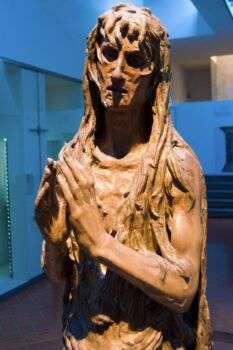
Image source: https://search.creativecommons.org/photos/df3a84c1-3fd9-4b92-beb6-7bd0b82ddbc5 by Maarten Dirkse
Info sources:
http://www.visual-arts-cork.com/sculpture/david-by-donatello.htm
http://www.italianrenaissance.org/donatellos-david/
http://www.artble.com/artists/donatello
